
The Salsoloideae are a subfamily of the Amaranthaceae, formerly in family Chenopodiaceae.

The Chenopodioideae are a subfamily of the flowering plant family Amaranthaceae in the APG III system, which is largely based on molecular phylogeny, but were included – together with other subfamilies – in the family Chenopodiaceae, or goosefoot family, in the Cronquist system.

Gagea is a large genus of spring flowers in the lily family. It is found primarily in Eurasia with a few species extending into North Africa and one species in North America.

Salsola is a genus of the subfamily Salsoloideae in the family Amaranthaceae. The genus sensu stricto is distributed in Australia, central and southwestern Asia, North Africa, and the Mediterranean. Common names of various members of this genus and related genera are saltwort and tumbleweed or roly-poly. The genus name Salsola is from the Latin salsus, meaning 'salty'.

Halothamnus is a genus in the subfamily Salsoloideae of the family Amaranthaceae. The scientific name means "saltbush", from the Greek ἅλς 'salt' and θαμνος 'bush'. This refers either to salty habitats or to the accumulation of salt in the plants. The genus is distributed from Southwest and Central Asia to the Arabian peninsula and East Africa.

Halothamnus subaphyllus is a species of the plant genus Halothamnus, that belongs to the subfamily Salsoloideae within the family Amaranthaceae,. It occurs in Southwest and Central Asia.

Halothamnus glaucus is a species of the plant genus Halothamnus, that belongs to the subfamily Salsoloideae of the family Amaranthaceae,. It occurs in Western and Central Asia.

Halothamnus auriculus is a species of the plant genus Halothamnus, that belongs to the subfamily Salsoloideae of the family Amaranthaceae,. It occurs in Western and Middle Asia.
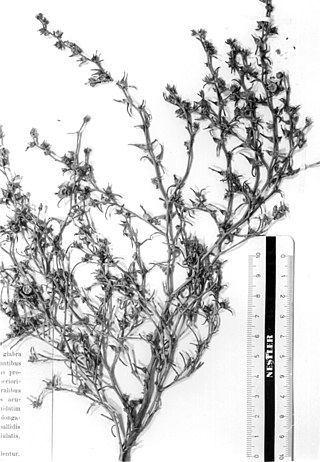
Halothamnus iliensis is a species of the plant genus Halothamnus, that belongs to the subfamily Salsoloideae of the family Amaranthaceae,. It occurs in Central Asia.

Halothamnus lancifolius is a species of the plant genus Halothamnus, that belongs to the subfamily Salsoloideae within the family Amaranthaceae,. It occurs in Southwest Asia.
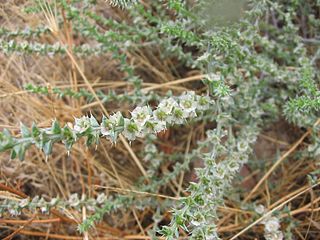
Kali was a genus of plants in the subfamily Salsoloideae in the family Amaranthaceae, that has now been subsumed into the genus Salsola.
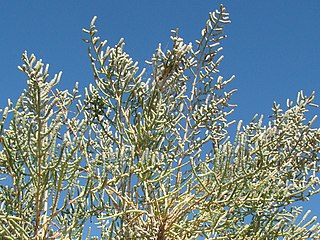
Halostachys is a genus of flowering plants in the plant family Amaranthaceae, containing a single species, Halostachys caspica. The plants are small to medium halophytic shrubs with apparently jointed fleshy stems and scale-like leaves. They are native to western and central Asia and northern China.
Caroxylon imbricatum, synonym Salsola imbricata, is a small species of shrub in the family Amaranthaceae. It grows in deserts and arid regions of north Africa, the Arabian Peninsula and southwestern Asia.

Caroxylon vermiculatum, commonly known as Mediterranean saltwort, is a perennial plant in the family Amaranthaceae. It has many synonyms, including Salsola vermiculata and Nitrosalsola vermiculata. It is native to arid and semi-arid regions of the Middle East, North Africa and southern Europe where it is used as a fodder plant for livestock.
Arthrocnemum was a genus of shrubs in the family Amaranthaceae. Two or three species were included in the genus. They are halophytes with fleshy, apparently articulated plant stems and reduced leaves and flowers.
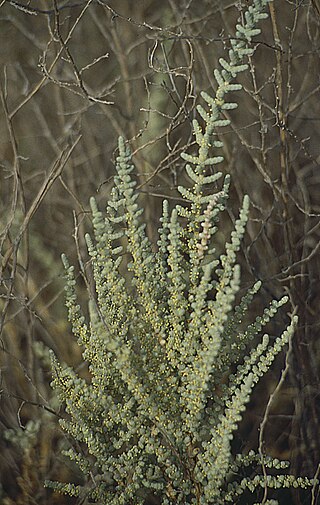
Halocnemum is a genus of halophytic shrubs in the family Amaranthaceae. The plants are fleshy and apparently articulated with characteristic globular or short-cylindrical lateral branches, and reduced leaves and flowers. There are three or two species, occurring from Southern Europe and North Africa to Asia.

Caroxylon aphyllum is a small species of shrub in the family Amaranthaceae.

The taxonomy of Tulipa places the genus in the family Liliaceae, and subdivides it as four subgenera, and comprises about 75 species.
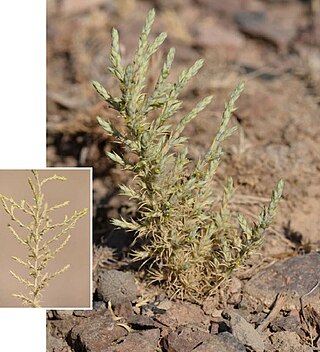
Girgensohnia is a small genus of plants in the family Amaranthaceae. They range from the eastern Mediterranean to the Caucasus, central Asia, Pakistan, and Xinjiang.

Petrosimonia is a genus of flowering plants belonging to the family Amaranthaceae. It is also in the Salsoloideae tribe.
















